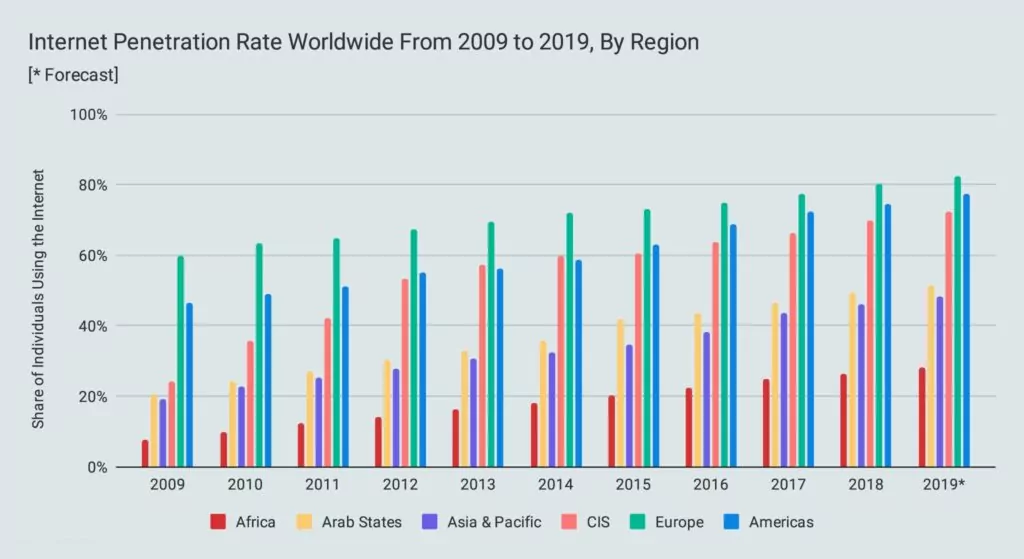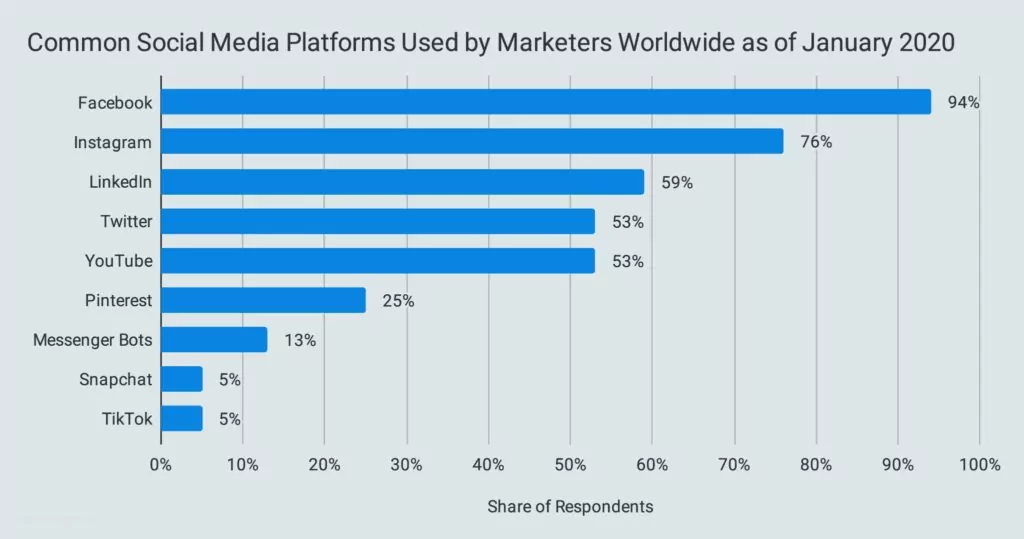Here’s what the Internet full form stands for:
Internet doesn’t stand for International Network or Interconnected Network—neither is correct.
The word Internet is a combination of the prefix inter-, from the Latin word inter meaning between or among, and net which is short for network.
So Internet simply stands for among or between networks.
So if you want to learn all about what the Internet stands for exactly, then this article is for you.
Without further ado, let’s do this!

What Does Internet Stand For?
The Internet is one of the most important technological advances in the history of man.
As a result, people often wonder where the word came from and what it means.
In fact, there are a number of myths about the word’s origins.
Some people think that it is an abbreviation for “International Network,” and others claim that it is short for “Interconnected network.” The reality is that it is neither.
The word “Internet” is a combination of the prefix “inter-,“ from the Latin word “inter” meaning “between” or “among,” and “net” which is short for “network.”
So Internet simply means, “among or between networks.”
How Did the Concept of the Internet Start & Evolve?
The concept that later became the Internet was born in August of 1962, in memos by J.C.R Licklider of MIT.
He discussed his vision of the concept whereby a set of computers could be interconnected on a global level, thereby providing access to programs and data to people in different locations.
In October of the same year, he became the head of the computer research program at the Defense Advanced Research Projects Agency (DARPA), and he convinced his successors, including Lawrence G. Roberts, that the Internet was an important concept.
In 1967, Roberts published a plan for the “ARPANET,” the predecessor to the Internet, and in 1968, Roberts and his team began to develop one of the most important components: the packet switches that would be used in place of circuits to allow communication between remote computers.
In 1969, the first computer-to-computer message was successfully sent, and the following years saw more and more computers added to the ARPANET.
By 1972, network users were able to develop applications to use on ARPANET, and in this same year, “electronic mail” was introduced. It took off, and people began to see the possibilities ahead.
The Beginning of the Internet
The original ARPANET system was a closed architecture network, so one method joined networks together, and there was a computer-to-computer connection where bits of information could be shared.
Bob Kahn played a huge role in designing this system, and he introduced the concept of “internetting,” which is an open network architecture that allows networks that are designed and developed separately.
The concept of “internetting” was that different networks with unique designs and functions could communicate and share applications.
The design of ARPANET was not sufficient for this open-architecture network, so Kahn decided to create a new protocol that could meet its needs.
This protocol is the Transmission Control Protocol/Internet Protocol (TCP/IP).
It would function more similarly to a communications protocol than a device driver.
In 1973, he invited Stanford researcher Vincent Cerf to help him design the protocol.
They published a paper for the International Network Working Group (INWG) in 1973, and the term “Internet” was born.
Growth of the Internet
As researchers explored ways to improve and further develop the Internet, other technologies including LANs, PCs, and workstations were developed.
TCPs were improved to accommodate different application suites and performance objectives of different devices, which showed that workstations and personal computers could be a part of the Internet.
As the Internet grew, the number of hosts grew along with it, and there was a need to allow networks to be independently managed.
The Domain Name System (DNS) was created by Paul Mockapetris. With this change, the routers had trouble keeping up, so the system of routing was replaced by the Exterior Gateway Protocol (EGP), which tied different regions together.
By 1985, the Internet was a well-established technology that connected a number of developers and researchers, and it was being used in various communities for email and other communications.
During this time, other computer researchers were working on other networking, but they were mostly closed within their respective communities.
In fact, universities that received funding were required to make the Internet available to all qualified users on their campuses.
Since then, the amount of Internet users has grown at a steady rate in all regions of the world.
In 2009, Internet penetration in Africa was the worldwide lowest at 7.6% but it eventually grew to 28.2% in 2019.

As of 2019, Europe had the highest Internet penetration worldwide with 82.5% of its population having access to the Internet.
The Internet Is Defined
The Internet began to grow and experience technological advances for the next 10 years, and more and more communities became connected.
On October 24, 1995, the FNC (Federal networking Council) passed a resolution that defined the term Internet:
- RESOLUTION: The Federal Networking Council (FNC) agrees that the following language reflects our definition of the term “Internet.”
- “Internet” refers to the global information system that:
- (i) is logically linked together by a globally unique address space based on the Internet Protocol (IP) or its subsequent extensions/follow-ons;
- (ii) is able to support communications using the Transmission Control Protocol/Internet Protocol (TCP/IP) suite or its subsequent extensions/follow-ons, and/or other IP-compatible protocols, and;
- (iii) provides, uses, or makes accessible, either publicly or privately, high-level services layered on the communications and related infrastructure described herein.
- “Internet” refers to the global information system that:
The Internet Today
The Internet today has grown beyond email, web pages, and discussion boards to incorporate places where people collaborate, engage in commerce, and share.
Social media has transformed all aspects of society in terms of marketing, political campaigns, the news, and more.
If you want to see just how widespread use of the Internet is, check out Internet Live Stats, a website that shows live counters of Internet users in the world and on websites, email, and more.
At this moment, there are 4,467,484,737 Internet users according to the site.
What Is the Internet Today?

The Internet has evolved from a concept of connecting remote computers to a huge global network system that links millions of computers.
These networks serve government, business, academic, private, and public purposes, and data is exchanged worldwide through these connections.
The Internet is no longer limited to computer connections; many devices—including smartphones, tablets, video consoles, TVs, and more—can use an Internet connection to access and share information.
People can send emails, access websites, make purchases, collaborate, watch movies, play games, and so much more.
In fact, businesses have even utilized the Internet for their marketing strategies through social media marketing.
There are various social networking sites available but Facebook remains at the top as the most commonly used social media platform worldwide, with 94% of social media marketers using the said network to promote their business.

The Internet has transformed the way people live.
Politicians offer live streams via the Internet, and people Tweet their opinions.
So much information is readily available within seconds, and people can communicate with friends and family anywhere in the world at no cost.
People can collaborate from remote locations, making the world even more accessible.
What Are the Important Features of the Internet? (3 Applications)
The Internet is a carrier for many of the applications that people use in everyday life including e-commerce, email, online chat, file sharing, file transfer, text and multimedia data, online gaming, and more.
The Internet is the means by which the following applications are shared.
Take a look:
#1 Email
The email was created around the same time as the Internet.
Today, almost everyone on the planet has an email address, and there are many choices for getting one.
Email addresses can be free from providers such as Google or Yahoo, or they can be self-hosted with someone’s specific web address.
#2 E-Commerce
E-commerce has been revolutionary for businesses and consumers alike.
E-commerce sites allow consumers to shop from home which can drastically reduce businesses’ operating costs or supplement their brick-and-mortar presence.
Small businesses worldwide have become more successful because of the Internet since they can reach a wide audience.
#3 File Transfer and File Sharing
The Internet was created for the purpose of file transfer and file sharing, and today it is easier than ever before.
Large files can be uploaded for recipients, and email attachments can be sent with ease.
It is easier and more reliable to keep records and collaborate.
Is the Internet the Same as the WWW?
The WWW is an acronym for the World Wide Web. The WWW is not the same thing as the Internet.
The Internet is the protocol that allows for the interconnectivity of networks, and the WWW is an application that uses the Internet.
The WWW is basically an information system that identifies links with URLs (Uniform Resource Locators), and they are accessible over the Internet.
Each website has a distinct URL.
Why Do People Think That Internet Means “Interconnected Network”?
Some people claim that the Internet’s full form is “Interconnected Network.”
This is a logical explanation for the term, as the Internet is made up of many different networks that can access and share information.
However, it is a common misconception because the term was first coined from “Internetting,” which referred to connecting different networks.
Why Do People Think That Internet Means “International Network”?
In 1973, Bob Kahn and Vincent Cerf published a paper on the concept of internetting on an open architecture network by way of a TCP/IP.
They presented this paper to the International Network Working Group (INWG), and this was truly the beginning of the Internet that we know today.
As a result, some people mistakenly think that the term Internet came from the first two words in the group’s name, International network.
However, this is not the case. Kahn and Cerf had already referred to their new open-architecture process as “internetting,” and Internet was simply the noun form of that term.
Internet is a combination of the Latin prefix, “inter-“ and the shortened form of the word network, “net.”
Together, it means among or between networks, and the idea was that different network systems could communicate and share information.
What Are Other Vital Tech Words and Their Meanings?
Here’s a list of particularly interesting tech acronyms—or maybe they’re not even acronyms?
Learn what these stand for:

